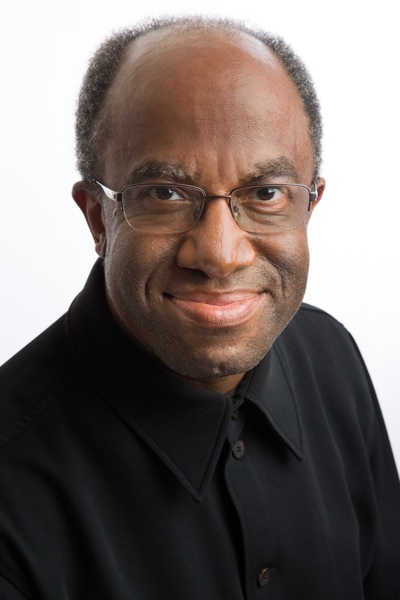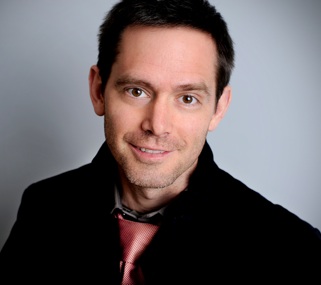The best of all possible worlds?
The Paramount Theater, Oakland’s restored Art Deco palace, was filled last Friday with fantastical music and absurdist theater in Leonard Bernstein’s satirical masterpiece, Candide. Based on Voltaire’s heady romp and critique of society, it poses a philosophical nut and then blasts away at it.
But that philosophical debate is accomplished with such infectious melodies and pin-turn plot twists that it is truly subservient to the loving business of art, and that is as it ought.
 Michael Morgan conducted a tight and exhilarating opening overture and then turned to the audience as our narrator to read the prologue.
Michael Morgan conducted a tight and exhilarating opening overture and then turned to the audience as our narrator to read the prologue.
“Voltaire’s Candide was a small novella in which no one sings. Bernstein’s Candide is a large operetta in which everyone insists upon it,” was his droll introduction. But then he took a turn off-book to describe the politics of the monarchy and the Church under which Voltaire labored, and then rattled our complacence by describing Bernstein’s modern milieu – cold war and our own McCarthy era witch-hunts.
Morgan was studying conducting at the prestigious Tanglewood Summer music festival when he first met Bernstein, who was a genius in many realms – composer, pianist and conductor, along with his strong advocacy of both popular music and of education, which he did at Tanglewood and with his beloved “Young People’s Concerts.”
His jazz-infused rhythms were revolutionary for classical compositions, with his 1953 West Side Story following Gershwin’s 1934 Porgy and Bess to develop American vernaculars into thrilling art. He began to compose Candide in the same period, but revised it multiple times over the next forty years, strangely appropriate for the satiric material.
This performance was a high-spirited tribute to Bernstein, led by eleven fine soloists and supported by a mighty effort from the Oakland Symphony Chorus, who not only cleanly enunciated their rapid-fire and rhythmically challenging lyrics, but also paraded a series of costumes and props.
And those principals! Thomas Glenn shone as Candide, the young man who is cast out from Westphalia to wander the world. His clean tenor won a Grammy award in 2012 for the role of Robert Wilson in John Adams’ Dr. Atomic. As Candide he was an earnest and good-hearted bumbler, an Everyman, but with Bernstein’s penchant for odd musical intervals, making for difficult but catchy tunes. Glenn was heartfelt in the teary “Goodbye, Cunegonde” and exotic and riveting in “El Dorado,” where his climbing and falling thirds rode across the chorus’ rising and falling scales.
Opposite him Shawnette Sulker played the love object, Cunegonde, in a coloratura soprano that was eye-popping. She sang “Glitter and Be Gay” with acrobatic ease and precision, combined with vamping wiggles that forced Morgan to stop for our long applause.
 Robert Sims played Pangloss, a philosopher who teaches that “all is for the best in this best of all possible worlds” – and it almost seemed believable when delivered in his wondrously plush baritone. Katy Stephan joined those three in a quartet that required razor timing, adding her own silken richness. And augmenting these was Tami Dahbura as the Old Woman, bringing musical theater acting chops and perfect comic timing along with a svelte soprano. In her Tango she was a polyglot force of nature. Hadleigh Adams, another SF Opera Adler fellow, was another combination of rich baritone and comedic talent as Cunegonde’s hapless brother.
Robert Sims played Pangloss, a philosopher who teaches that “all is for the best in this best of all possible worlds” – and it almost seemed believable when delivered in his wondrously plush baritone. Katy Stephan joined those three in a quartet that required razor timing, adding her own silken richness. And augmenting these was Tami Dahbura as the Old Woman, bringing musical theater acting chops and perfect comic timing along with a svelte soprano. In her Tango she was a polyglot force of nature. Hadleigh Adams, another SF Opera Adler fellow, was another combination of rich baritone and comedic talent as Cunegonde’s hapless brother.
Bernstein’s richness of melodies and taxing quartets were awe-inspiring. But there was something central about Cunegonde’s “Glitter and Be Gay.” As Sulker alternated between mournful minor stanzas and zany upbeat ones, her character flip-flopped between an unexpected life as a courtesan and a love of glitter. Musically, Sulker’s clear light tones were arrayed against the dark hues of an English horn, a lovely texture that also seemed to touch on the tension between Pangloss’ optimistic philosophy and the starker plot, which is overflowing with murder, rape, war and torture… in a fun-filled way!
The orchestra was slightly reduced, closer to an opera orchestra, but filled the hall surprisingly deeply (and I think the Paramount is finally getting some subtle electronic enhancement). Andrea Plesnarski was stirring in that English horn duet, and excellent on oboe throughout as well. Flutists Alice Lenaghan and Rena Urso-Trapani and clarinetist Diane Maltester rounded out a great wind section. The brass were pure dynamite, with a special hats off to trumpet player William Harvey and the incisive trombones, and the strings were, as usual, crisp and melting in all the right places.
 In fact, the orchestra was unbelievably tight, and it may even have been personal for some of them. “I met Bernstein at Boston’s Berklee School of Music. This was on my bucket list,” said Assistant Principal cellist Joseph Hébert after the concert. “What orchestra is going to commit to an entire concert of this?” He shook his head. “And also the [Bernstein] Mass was on my list! Morgan has done several of my bucket list pieces.”
In fact, the orchestra was unbelievably tight, and it may even have been personal for some of them. “I met Bernstein at Boston’s Berklee School of Music. This was on my bucket list,” said Assistant Principal cellist Joseph Hébert after the concert. “What orchestra is going to commit to an entire concert of this?” He shook his head. “And also the [Bernstein] Mass was on my list! Morgan has done several of my bucket list pieces.”
Board President James Bell described Michael Morgan afterwards as “A practitioner of the absurd, and an antidote,” to which Morgan replied, “Each year I wonder how I’m going to top the last season. Don’t ask me to top this.”
Despite two hours of Bernstein’s numerous melodies, I left remembering the chorus throwing themselves into the Spanish Inquisition: “What a day, what a day, for an auto-de-fe!”
This season is over, but you can hear this fine ensemble in their July 3 Independence Eve celebration at Richmond’s Craneway Pavilion, complete with fireworks. This is free, so come early and park far away!
—Adam Broner
Photos: top, Michael Morgan, photo by Marco Sanchez; below, Thomas Glenn, photo by Laura Bunker; and bottom, Shawnette Sulker, photo by Betsy Kershner.
